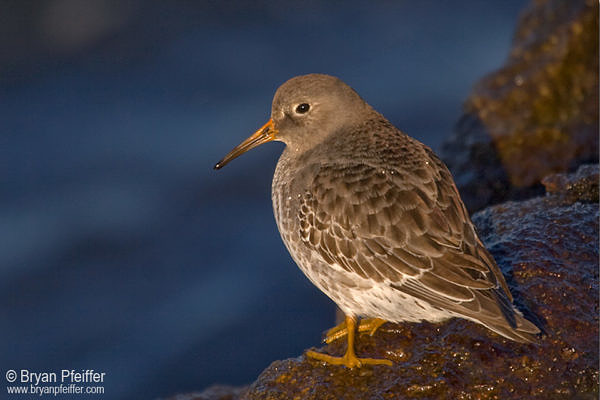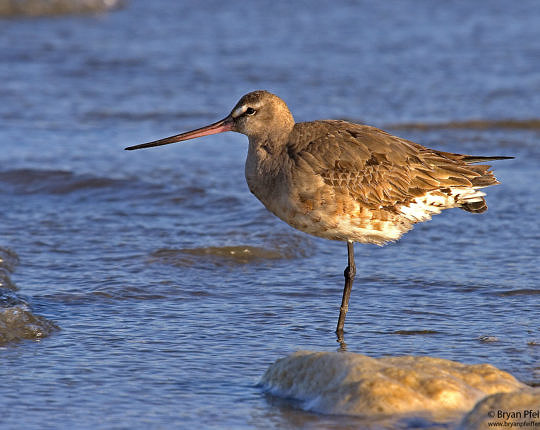
Solving Shorebirds
Across great distances they migrate, powered on a diet of arthropods and a burst of determination. When they stop to visit the mud, they are among the most watchable of all wildlife, feeding and breeding in full-frontal view. We have given them some of our most entertaining bird names: Hudsonian Godwit, Short-billed Dowitcher, Bristle-thighed Curlew, Piping Plover.
Here’s a lesson on shorebirds for the landlocked birdwatcher.
First, recognize that most of your learning won’t work without a spotting scope, a field guide, patience and some quality time on the coast. Use your field guide as a textbook as you read on. Then, for a test, a tough one, check out my Shorebird Challenge.
Tides and Light – For shorebirding along the coast, the next best thing to a field guide is a tide table. The mudflats on the Merrimack River in Newburyport, Massachusetts, for example, are underwater at high tide; so you won’t find shorebirds there. Many will have sought high ground on Plum Island. And if you go to Plum Island at low tide, most of the shorebirds will have left to feed elsewhere. Conditions vary, but it’s often nice to bird mudflats on a rising tide, which pushes shorebirds your way. Also be aware of high, harsh, late-summer sun, which tends to flatten your views and make everything look dingy and ill-defined. Low light at your back and the right tide produce shorebirding bliss.
Plumage – Ah, the molt. During migration in spring and fall, many shorebirds do not sport their distinctive breeding plumage and can look rather drab and gray. Sometimes adults are in transition from winter to breeding plumage. Compounding matters is that immature and adult shorebirds can show up together in migration in the fall.So you’ll find plumage variations in the same species. But don’t fret the uniformity of color. Size, body shape, behavior, bill length and leg color are great tools for identification; sometimes they’re all you’ve got. So learn shorebird feather and body morphology. (See your field guide.) Below are some tips on what to consider when you see plain gray running around out on the mud:
Size, Shape and Posture – Get a sense of size, often by comparing the bird to a known species nearby. Black-bellied Plover (almost a foot long) is a common and useful measuring stick on the coast. Also look at body shape, but realize that it can change with changing behavior (i.e. feeding or a state of alarm). A bird bent over and feeding calmly will stand at attention if a Merlin is buzzing the flock. Nevertheless, get an overall sense of the bird’s posture. Does it tend to be bent over with its belly nearly dragging in the mud? Or is it upright on long legs? Does it have a long, elegant neck? Or is it a little feathery football with a head?
Bill, Legs and Plumage – Consider bill length and shape. Is the bill short and stubby? Long and elegant? Upturned or downturned? Compare the bill length to the width of the head in profile. Leg length and color can help – but realize that yellow legs can appear dark in lousy light or if they’re covered with mud. Do use plumage when it’s available. And don’t give up on a shorebird if it takes flight. Note rump color on birds in flight (or even at rest) and the presence or absence of wing stripes.
Behavior and Sound – In some cases, watching how the birds behave and feed can help with identification. Plovers run and search visually for food: they display a run-pause-run-dip pattern of feeding. Sandpipers are more like feeding machines. Dowitchers, for example, often feed in water up to their bellies; they methodically jab like sewing machines. Least Sandpipers tend to prefer drier ground compared to their close relatives, and they peck rather than plunge. Spotted Sandpipers display a funny tail bobbing and fly on stiff wings. We don’t use vocalization with shorebirds as much as we do with songbirds, but listen nonetheless: the Least Sandpiper’s “kreeep” and the Long-billed Dowitcher’s “keeek” are distinctive and diagnostic.
Common Shorebird Family Characteristics
Consult your field guide as you review these traits shared by families and genera of shorebirds.
Plovers – These tend to be plump with short bills and have bold breeding plumage. They dart across the mud or grass, stop, look around, maybe bend over to feed, and then dart again. They come in two sizes: small and medium. None of our plover species has a long bill. For smaller plovers (such as Semipalmated, Piping, Wilson’s and Snowy) use plumage and classic field marks (including leg color) at any time of year. Our larger common plovers – Black-bellied and American Golden – tend to present the greatest identification challenge. Note relative bill size (daintier on Golden plovers) and the crown (darker on Golden plovers). In flight, Black-bellies have dark axillaries (“wing-pits”).
Sandpipers – Many of these have longer, more elegant bills, although some (the “peeps”) have shorter bills. This family includes a variety of species. Here are summaries of a few common types, grouped here because they tend to share size, shape and behavior:
- Yellowlegs and Willet – Yellowlegs (Greater and Lesser) have longish, highway-paint-yellow legs, elegant necks and heads and a white rump and upper tail in flight. Willets look similar but are overall more robust with thicker bills; they have pale, grayish legs and a bold black-and-white wing pattern in flight.
- Solitary and Spotted Sandpipers – Medium-sized, similar sandpipers. Both bob their tails (Spotted more so). In breeding plumage, Spotted Sandpiper, with a belly like a Dalmatian, is distinctive. Solitary Sandpiper has a similar shape, gray-brown head and neck (“dipped in graphite”) with a white eye-ring and checkered outer tail feathers. But note that juvenile and winter-plumage Spotted Sandpipers do not have spots and can look a bit like Solitary Sandpipers. These young and winter spotties have a “white wedge” of plumage on the sides of the breast.
- Godwits – These are large, wonderful waders with long, slightly upturned bills. They tend to feed in deeper water and are often (based on size alone) the first “oh-wow” shorebird to pop up in a routine scan.
- Ruddy Turnstone and Purple Sandpiper – Plump with shortish bills. Turnstones (which do turn over stones on the shoreline) are distinctive even in winter with a dark black bib. In winter they often retain hints of their warm, ruddy backs. Purple sandpipers, almost exclusively coastal, often hang out on rock and jetties (sometimes with turnstones); we rarely find them walking in sand. They aren’t purple.
- Sanderling and Dunlin – Although they’re brick red in breeding plumage, Sanderlings are plain gray and white when we usually see them. They’re the classic beach-runners. They have a white wing stripe in flight and a medium-to-short bill. Dunlins are also gray-brown when we often see them, a far cry from their ruddy back and black bellies in breeding plumage. You’ll sometimes see hints of the black belly in migration. Compared to Peeps, Dunlins are plump and bent over with a longish, sturdy drooping bill.
- Peeps – Either the bane of shorebirding or a delightful challenge. They’re tiny, horizontal and variable. Little Nerf footballs with legs. Our peeps include Semipalmated, Western, Least, White-rumped and Baird’s sandpipers. Plumage is often secondary in identification. On a White-rumped Sandpiper, for example, the white rump is hard to see; overall length and shape is better than rump pattern. The key to peep ID is training yourself to see subtle differences in shape and size, bill length and posture. Consult your field guide. Concentrate on the subtleties.
- Dowitchers – Medium-sized with longish, straight bills and relatively short legs. They feed with methodical jabbing motion like a sewing machine as they stand still or move gradually foreword. Many other sandpipers cover more ground and peck while feeding. It’s tricky to separate adult dowitcher species in winter plumage; the juveniles are easier. Habitat, time of migration, and call notes are helpful.
Others
- Stilt Sandpiper is a bit like a cross between a yellowlegs (with yellow-green legs) and a dowitcher. It often feeds in deeper water with dowitchers. It has a fairly straight bill that droops slightly at the tip.
- Red Knot is a classic “in-betweener.” It’s often not red when we see it in migration. It is medium-sized with a straight, medium-length bill. In posture, it falls between the elegance of yellowlegs and the stubbiness of peep. It is also a species in trouble, declining at an alarming rate.
- Phalaropes are relatively uncommon, elegant and spin like a top as they feed in deeper water. Females have the more dramatic breeding plumage. In order of abundance, you’ll find Wilson’s, then Red-necked, then Red (often rare).
- Upland Sandpiper is a grassland species not found among other shorebirds. It is distinctive for its elegant neck, small head and beady eye. We fondly call it “Pinhead.”
- Buff-breasted Sandpiper is medium-sized with a small head, pert markings and a slender bill. It tends to prefer drier ground or even grass, but you’ll sometimes (rarely) find it among other shorebirds on the beach.
- Whimbrel and Long-billed Curlew (and other curlews) are big and dramatic with decurved bills. Don’t be surprised to find them in grasslands or dry mud.
- Wilson’s Snipe and American Woodcock are more familiar because they are inland breeding sandpipers with distinctive displays, vocalizations and wing noises. We often flush Snipes from wet fields or cattail patches. Woodcocks like wet, shrubby areas and are essentially never found among other shorebirds




Nine years after the first comment, this page is still helpful.
This is a great, succinct guide that will be very useful to the occasional shore birder. Thanks for putting this up!
Thanks, Alan. It’s an honor to hear that from someone with your domain name! 🙂
-Bryan
Thanks, Bryan! Very helpful and timely!